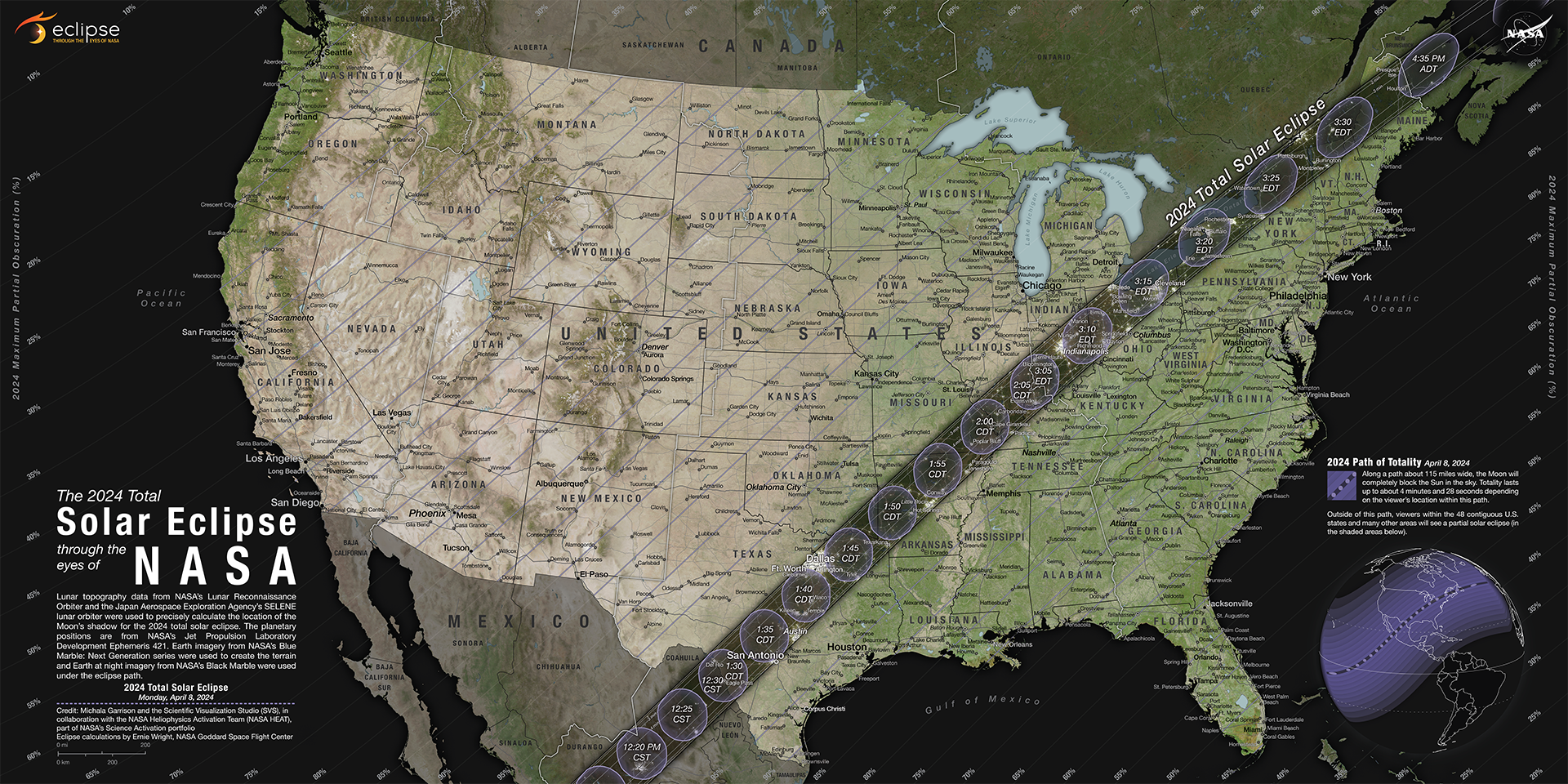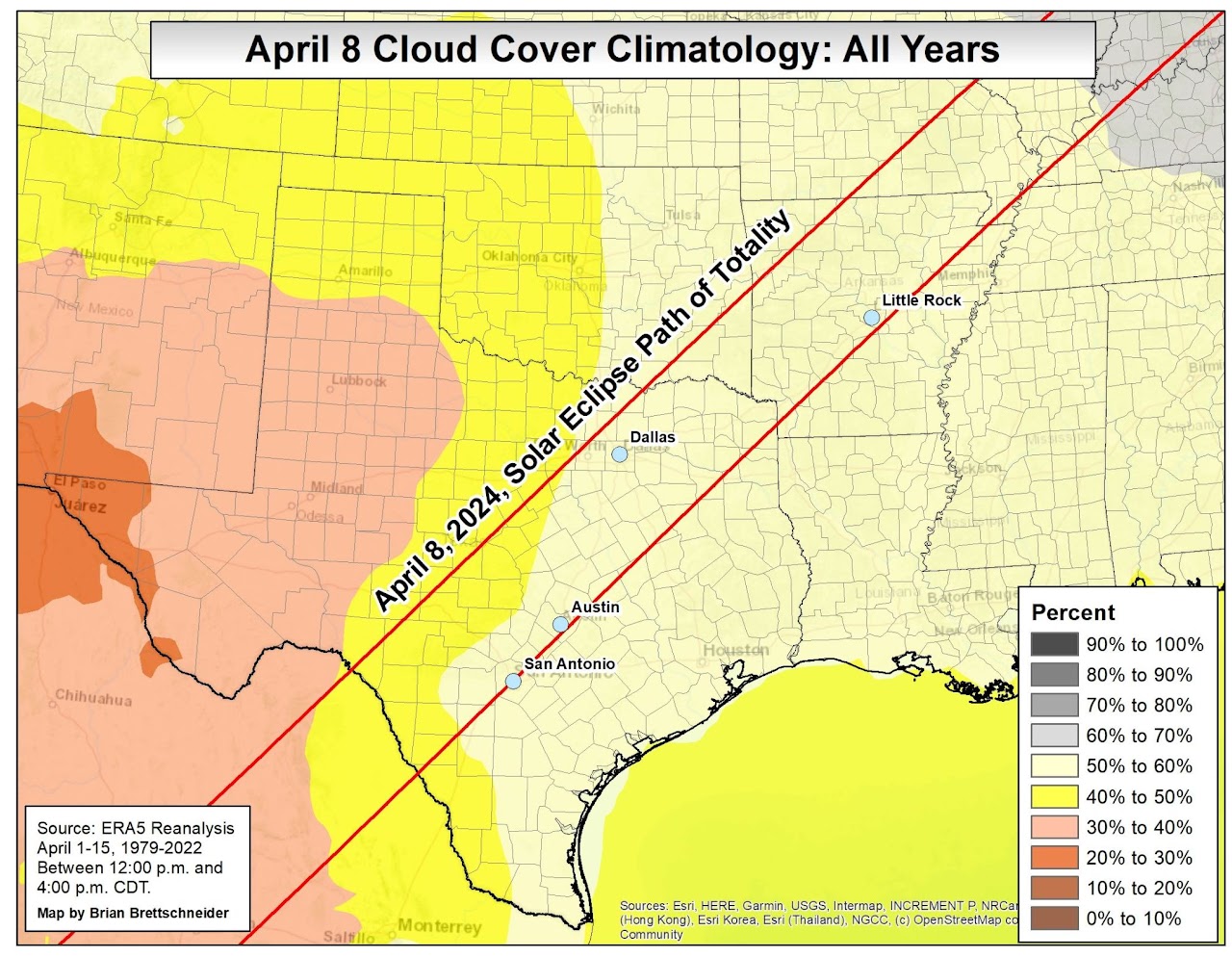April 8, 2024 Solar Eclipse

A solar eclipse will occur across North America on April 8, 2024, passing over portions of the Southern Plains, Middle and Lower Mississippi Valleys, and northeast into Canada. A total solar eclipse will occur across portions of northeast Arkansas and the Missouri Bootheel. A partial solar eclipse will occur across the remainder of the Mid-South. Click the image above to zoom in on the solar eclipse graphic.
What is a Total Solar Eclipse?
According to NASA, a total solar eclipse happens when the Moon passes between the Sun and Earth, completely blocking the face of the Sun. People located in the center of the Moon's shadow when it hits Earth will experience a total solar eclipse. Learn more about the different types of eclipses here.
Timing Tables for a Total Solar Eclipse
| City |
Eclipse Begins |
Totality Begins |
Totality Peak |
Totality End |
Eclipse End |
Totality Duration |
| Jonesboro, AR |
12:37 PM |
1:55 PM |
1:55 PM |
1:57 PM |
3:14 PM |
2 min 17 sec |
| Corning, AR |
12:39 PM |
1:55 PM |
1:57 PM |
1:59 PM |
3:15 PM |
3 min 56 sec |
| Paragould, AR |
12:38 PM |
1:55 PM |
1:57 PM |
1:59 PM |
3:15 PM |
2 min 50 sec |
| Kennett, MO |
12:39 PM |
1:57 PM |
1:58 PM |
1:59 PM |
3:16 PM |
2 min 17 sec |
Timing Tables for Partial Solar Eclipse
| City |
Eclipse Begins |
Maximum Eclipse |
Eclipse Ends |
Obscuration |
| Memphis, TN |
12:37 PM |
1:58 PM |
3:14 PM |
97.7% |
| Jackson, TN |
12:40 PM |
1:59 PM |
3:17 PM |
97.1% |
| Tupelo, MS |
12:38 PM |
1:58 PM |
3:15 PM |
92.6% |
For additional eclipse times and duration for a specific location, please visit NASA's Eclipse Explorer.
Local Climatology

Click on the links above for a detailed forecast for the cities in the table. For additional forecast information, please visit our Forecast Points Page and enter your location.
What effects might the eclipse have on the weather?
Research has shown that temperatures can drop between 4-10 degrees Fahrenheit during the eclipse. In addition, some reduction in wind speed and low-level clouds are possible.
What can people expect during the eclipse?
During the eclipse, the sky will get dark as if it were dawn or dusk. Even if skies are cloudy, people will still notice a darkening of the sky. Nocturnal wildlife may awaken while non-nocturnal wildlife may think it’s time for bed.
Protecting your eyes and skin during a solar eclipse
Except during the brief totality of a total solar eclipse, when the Moon completely blocks the Sun’s bright face, it is not safe to look directly at the Sun without specialized eye protection for solar viewing. Looking at any part of the bright Sun through a camera lens, binoculars, or a telescope without a special-purpose solar filter secured over the front of the optics will instantly cause severe eye injury.
Below are some important safety guidelines to follow during a total solar eclipse courtesy of NASA:
-
View the Sun through eclipse glasses or a handheld solar viewer during the partial eclipse phases before and after totality.
-
You can view the eclipse directly without proper eye protection only when the Moon completely obscures the Sun's bright face - during the brief period known as totality. (You'll know it's safe when you no longer see any part of the Sun through eclipse glasses or a solar viewer.)
-
As soon as you see even a little bit of the bright Sun reappear after totality, immediately put your eclipse glasses back on or use a handheld solar viewer to look at the Sun.
-
Even during an eclipse, or during the partial phases of a total eclipse, the Sun will still be very bright. If you are watching an entire eclipse, you may be in direct sunlight for hours. Remember to wear sunscreen, a hat, and protective clothing to prevent skin damage.
Additional Resources

